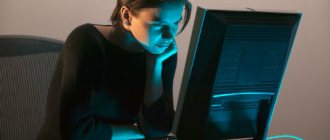Breathing is a vital process without which the body cannot function. Moreover, in order to perform it, a person does not need to control his every inhalation and exhalation - this happens without his intervention.
People engaged in spiritual practices are discovering more and more new tools for self-knowledge. One of these tools is breathing exercises, with the help of which you can not only support the physiological needs of the body, but also improve the psycho-emotional background and even achieve a state of enlightenment.
Today we will talk about holotropic breathing, a technique developed to regulate a person’s mental state.
What is Holotropic Breathwork?
If we break down the term “holotropic” into parts, its origin comes from the Greek words holos (translated: whole, whole) and tropein (leading). When the meanings of the translated terms are combined, the result is “breath leading to wholeness.” This is a type of psychotherapy that works on a person’s personal growth and consists of a special breathing technique that people practice for a certain time while listening to music.
Holotropic breathing triggers a whole chain of chemical reactions in the human body, which leads to changes in the functioning of the nervous system: structures responsible for unconscious processes, long-term memory, and emotions are activated. This is how breathing therapy occurs at a deep level, which frees the individual from long-standing psychological trauma. After a certain time, the patient is transformed and cured of his illness.
Breathwork using holotropic techniques was developed by an American psychologist named Stanislav Grof in the fifties. Twenty years later, when many positive studies had been done, the technique was officially recognized and approved throughout the world as an alternative method. It is used instead of the use of psychotropic drugs and is considered an effective therapy for patients.
The goal of breathwork therapy using holotropic techniques is to heal the individual so that he or she achieves wholeness while descending into one of the deepest levels of consciousness. The basis on which this technique is based is the totality of spiritual and psychological practices throughout the world acquired by humanity over many millennia of existence.
In fact, classes that include this unique technique look like this: rapid, deep, coherent breathing is performed without pauses between inhalation and exhalation; The exercises are accompanied by stimulating rhythmic music. As a result, a person is immersed in an unusual state, during which he receives a stream of unconscious experience. Next, drawing, dancing, and discussion of the ongoing process are connected to the technique.
- For what reasons may a pension increase be denied?
- Lutein Forte - instructions for use, composition of vitamins for the eyes, indications, analogues and price
- Who are close relatives when making a gift - specifics of the contract and taxation
How to do holotropic breathing yourself at home?
To transition to another state of consciousness, the holonaut should lie on the floor. In the first 20 minutes after the start of the session, the patient is immersed in a trance. Subsequent sensations are associated with tension in the body, spasms or pain. Rhythmic breathing through the mouth should be frequent, deep and continuous.
The upper chest should be involved in this process. Intense breathing, which causes hyperventilation, makes a person relive negative situations that happened in the past.
When exhaling air, the holonaut should imagine that negative emotions, negative thoughts, various diseases and problems are leaving at the same time. A holonaut in a trance state relaxes his muscles as much as possible. Simultaneously with intense breathing against the background of music, the holonaut engages the thinking process in order to smooth out tension in various parts of the body with the effort of thought.
During the session, a person needs to realize that negative moments emerging from the past no longer have an impact on the present. Having processed his own experience in his consciousness, the holonaut displaces from it the memories of past mistakes. After practicing active breathing, it is better to move on to creativity.
The most suitable tools for this purpose are:
- drawing;
- dancing;
- modeling, etc.
The spiritual states worked out during the session must be expressed creatively by the holonaut. Suitable conditions in practice help to create musical accompaniment.
Holotropic breathing: harm or benefit?
This breathing technique, like medications, has positive and negative effects on human health with side effects, so the opinions of psychotherapists are radically divided. Those who practice holotropic breathing claim that it is the safest way to treat psychological problems. The rest of the experts consider the technique very dangerous for the mental and physical condition of the patient. Here is the negative impact of this breathing technique on human health:
- It is compared to the way a woman breathes during childbirth, an athlete during a sprint race, or a tourist when climbing mountains. As a result, the following happens: the level of carbon dioxide in the tissues increases sharply, which causes hyperventilation of the lungs. These processes are a catalyst for such dangerous reactions as: reflex vasoconstriction, a sharp increase in blood pressure, a decrease in hemoglobin in the blood, and metabolic disorders. A person experiences temporary suffocation of the brain, and the nerve endings gradually begin to die.
- During one breathing exercise using holotropic technique, the human body loses up to three liters of carbon dioxide, which can lead to dizziness and loss of consciousness.
- If you perform such holotropic therapy on your own, without knowing all the features of the correct breathing technique, there is a risk of cerebral edema and death.
- By making even one incorrect manipulation during a breathing exercise using the holotropic technique at home, it is possible to cause irreparable harm to the central nervous system, myocardium, liver, and kidneys.
Psychotherapists who are supporters of the holotropic method of therapeutic breathing hold the opposite opinion. They claim that an absolutely healthy person who has no contraindications and has undergone professional training from Stanislav Grof’s followers in certified centers will receive only positive health effects. Here's how this technique affects the human body:
- Holotropic breathing is considered the fastest-acting technique among other psychotechniques. It leads to rapid personal changes. This happens because during a holotropic session, not each traumatic situation from the past is considered separately, but a whole generalizing block.
- Your internal system of the body itself chooses which psychological problem should be considered at the moment, thanks to which a specialist psychologist does not manipulate your consciousness (unlike other areas of psychotherapy). This is called the non-manipulative feature of holotropic technique.
- Breathing, on which this technique is based, helps to work through the deepest particles of the negative psychological experience received during the lesson.
- Thanks to classes using holotropic techniques, a person, while breathing, becomes aware of the roots of his psychological stress and is freed from them.
- The holotropic breathing technique effectively treats psychosomatic diseases (pathologies caused by a person’s negative psychological state) even in the most hopeless cases.
- The patient can easily overcome bad habits and addiction by attending classes based on rapid breathing.
- By performing the exercises of their holotropic technique, a person almost immediately gets rid of the consequences of chronic stress and fatigue, and a sense of inner harmony returns to him.
Differences between holotropic breathing and rebirthing and vibration techniques
Holotropic Breathwork is a type of healing that is included in the “Big Four” group according to its therapeutic purpose:
- Vivasion.
- Free breathing.
- Rebirthing.
- Holotropic breathing.
All mechanisms give the same result, but the difference between holotrope and the rebirthing technique lies not only in who is the developer of the method, but also in the way the session is conducted. Holotropic Breathwork was founded by a psychiatrist and rebirthing by a spiritual healer. Leonard Orr, unlike Stanislav Grof, emphasized an individual approach.
Holotrope has an optimal effect on the psyche during group sessions. Rebirthing is effective as an independent procedure, and not just a group healing method practiced by a coach. The breathing techniques under consideration have many common elements, but the contraindications to the use of these mechanisms are different.
Rebirthing sessions are not recommended for those suffering from serious mental disorders for which the relaxing procedures of the technique are too gentle. The holotropic technique is not recommended for people with severe limitations in movement. Both techniques provide the patient with the best understanding of his body.
The use of the vibration technique by experienced people does not require the presence of a trainer. The holotropic algorithm allows you to repress hopeless life experiences; an assistant is required during the procedure. Vivasion does not have as many contraindications as the holotropic healing method.
What else is holotropic breathing used for?
The holotropic technique with unique breathing cannot be considered a panacea for all ills and illnesses of people, but its use still has a positive effect in many cases. The use of such breathing psychotherapy is so widespread that it is compared to the infinite possibilities of human consciousness. Holotropic breathing is successfully used not only for the treatment of psychological pathologies. It is effective in the fight against excess weight; works well during drug or alcohol addiction therapy. How this breathing technique works to treat certain problems:
- For weight loss. During the application of breathing used in holotropic therapy, hyperventilation occurs. A huge amount of oxygen enters the body, which promotes the effective burning of fat cells. As a result of such breathing, metabolic processes are accelerated, and this helps cleanse the body of harmful substances and toxins.
- For the treatment of alcoholism. Holotropic breathing technique has a therapeutic effect for patients suffering from alcohol addiction. When using it, a person plunges into the depths of his consciousness and faces the negative experience that led him to this problem. The patient experiences this situation in his head in a new way, gains awareness and heals from the previous trauma. The need for alcohol doping disappears, which allows you to successfully overcome addiction.
Scientific studies of Holotropic Breathwork have shown the method to be highly effective for:
- Overcoming life crises
- Release from the consequences of traumatic experiences and stressful situations
- Therapy for emotional and psychosomatic disorders
- Addiction therapy
- Treatments for depression
- Weight loss
Holotropic breathing is one of the most effective transformational techniques in modern psychology, working with the area of consciousness and subconsciousness. This is a method of in-depth self-exploration that has great psychotherapeutic potential and is effective for solving psychological and psychosomatic problems.
Holotropic breathing has shown high effectiveness in working with depression, neurotic and psychosomatic symptoms, the consequences of acute and chronic stress, sexual disorders, difficulties in interpersonal relationships, and living through crisis states.
This technique is used to reveal creative abilities and internal resources, develop intuition, improve the quality of life and deep self-exploration.
How does a group session work?
To perform breathing using the holotropic technique, appropriate conditions are created in specialized centers that are aimed at relaxing a person and liberating him from negative experiences. This is achieved by fulfilling simple requirements that are necessary for classes:
- A group session using holotropic breathing techniques takes place in the form of seminars, the number of which depends on the individual problems of each visitor (from 8 to 15 sessions).
- The duration of one lesson can vary from three to eight hours.
- Participants are divided into pairs: one will play the role of a sitter (an assistant who ensures the safety of the person doing the breathing), and the other will play the role of a holonaut (the breather).
- The lesson begins with relaxation and relaxation accompanied by specially selected rhythmic music (it helps to maintain heart and respiratory rhythms).
- When the main stage of the breathing session comes to an end, all participants begin to express their emotions creatively: they draw, dance freely, and sculpt fancy figures from clay. If they want, they can discuss everything they experienced during these hours.
- The lesson is accompanied by specially selected music (read more about it below).
- Allergy ointment
- Scientists have compiled a typical portrait of a coronavirus victim
- How to put music on a video
Is it possible to master this technique on your own?
If you have clearly decided for yourself that you are capable of engaging in this method of self-knowledge, and have a great desire, at home, independently mastering the holotropic technique with a certain method of breathing is possible. Thanks to online resources, specialized literature, and various video lessons, you have a unique opportunity to conduct classes effectively. Read on to learn about the holotropic rapid breathing technique that you can practice at home on your own.
Holotropic breathing technique at home
When doing home exercises using holotropic techniques, the disadvantage for the fullness of the session is the absence of a sitter. If a novice trainee has the opportunity to secure a pair for himself, that’s ideal. The inability to perform an activity with a “nanny” cannot be an obstacle to the use of this technique. Here are some important tips for practicing at home using Holotropic Breathwork:
- Before the session, choose a comfortable room for your lesson, having previously ventilated it.
- Stock up on suitable music (for more details on this, see a separate paragraph below).
- Determine for yourself what specific problem you want to solve with the help of holotropic therapy with rapid breathing (personal or family, for example). You must breathe to achieve a specific effect, not for the sake of the process itself.
- Take as deep, frequent breaths as possible, and do not pause your breathing. Additional special recommendations are not needed here; this is a non-verbal technique, which consists of minimal intervention during the lesson. In some ways it can be compared to meditation.
- Use different body positions that your mind dictates.
- After experiencing an emotional experience, engage in your favorite creative process, for example, drawing images you see, dancing, modeling from clay or plasticine.
- You must become aware of the emotions you have experienced.
What kind of music is needed?
Choose music that is conducive to relaxation: sounds of nature, tambourine, drum roll. It will be better if you choose different music selections for each stage. First there should be a stimulating and motivating melody, then a dramatic one mixed with a dynamic one. At the end there should be a musical breakthrough with a transition to calmer, meditative music. Check out the step-by-step description of the musical accompaniment of the entire holotropic technique session:
- For the first 8 seconds of the lesson, light music should sound, encouraging and stimulating breathing.
- Before 20 seconds into class, record an even more breathing-stimulating melody.
- For the next 20 seconds of the holotropic session, an ethnic recording should be played using drumming.
- Afterwards, the intensity of the breathing exercise with holotropic technique is replaced by a trance state, so a dramatic melody should sound for the next 35 seconds.
- Then the drama subsides, and the style of musical accompaniment is replaced by heartfelt, warm music. This lasts for the next 15 seconds of the holotropic breathing session.
- Afterwards, the melody should smoothly turn into a calm one, but maintain intensity. This rhythm should be maintained until the very end of the holotropic breathing session.
The essence and capabilities of the respiratory system
Holotropic breathing implies the need for rapid breathing, performed taking into account certain recommendations and (preferably) in pairs. To perform the technique correctly you need:
Holotropic breathing on your own
- turn on meditative music (options are available on the Internet);
- lie down on a flat surface;
- randomly spread your arms and legs;
- close eyes;
- Dedicate the next 20-25 minutes to breathing: inhale through your mouth, taking a deep breath; take sharp breaths and smooth exhalations, control the frequency of the process, trying to carry it out as intensely and deeply as possible.
After completing the session, it is advisable to distract yourself: take a leisurely walk in the park (away from cars and exhaust fumes), take up drawing, go to an art gallery. If you have a four-legged pet, you can leisurely walk around the area with it, looking at the opening panorama. The activity should be as simple as possible, not requiring special concentration.
Medical contraindications for use
Before performing breathing exercises, you need to find out if you have any medical contraindications to the use of this technique. There are many contraindications to practicing this type of breathing. Check out the detailed list of diseases/indications, the presence of which prohibits holotropic therapy:
- In the process of conducting a lesson on rapid breathing, a person may experience emotional outbursts, stress, and physically feel his experiences (through an increase in body temperature, for example). For those who suffer from angina, hypertension, heart failure, asthma - all this is very dangerous and can be fatal.
- Pregnancy. This can lead to the death of the fetus in the womb.
- Classes using holotropic therapy are not indicated if a person suffers from epilepsy. The use of this technique increases the risk of a seizure from the received emotions.
- Do not practice holotropic techniques if you have recently undergone surgery or any trauma. Vigorous breathing exercises can cause the stitches to tear.
- Classes based on the holotropic technique are contraindicated during the acute stage of infectious diseases.
- Children under 14 years of age are not allowed to attend such sessions.
Tips for beginners
Before treatment with the active breathing method, a beginner needs to learn the rules of working in pairs. The place for conducting classes can be a hall without unnecessary objects. An unconscious person can injure himself if the room is filled with interior items.
Holotropic breathing sessions at home should be carried out with an assistant. The sitter or assistant must monitor the condition of the holonaut. During active breathing, the assistant must assist the patient at his request.
Before the lesson, the practitioner of the holotropic method must be focused and calm. It is better to conduct classes in comfortable clothes, removing all accessories. Before the session, you must remove contact lenses. It is better to eat in advance, and not immediately before the active breathing procedure, otherwise exercising on a full stomach will be difficult.
You should choose a sitter with special care. If the assistant cannot be trusted, then it is better to find another assistant. It is important to analyze the respiratory process, in which the sitter plays a large role. If the holonaut wants to stop the session, then you need to say the word “Stop”.
The breather should not be focused on his thoughts during exercise. After their completion, the sitter needs to make sure that everything is fine with the holonaut. The patient should not worry about anything if he has stopped breathing actively after working on himself under the supervision of a sitter.
Video lesson: How to learn to breathe correctly
If you want to use holotropic techniques effectively, it is important to learn how to breathe correctly. Otherwise, it will not only have no effect during therapy, but may even lead to huge health problems and irreversible processes in the body with a fatal outcome. Check out a comprehensive video tutorial below that teaches proper breathing techniques during a holotropic session. This way you will learn many useful recommendations and instructions that will help you get the healing effect from using this method.
Frequency and duration of classes
Holotropic breathwork is a type of healing used in psychotherapeutic practice. His method must be implemented in accordance with a special schedule, allowing sessions to be carried out at the right time. The procedure usually takes 2-3 hours. During this time, the process can be completed naturally, but there are also protracted sessions.
After the session, the presenter suggests moving on to the creative stage of working with the body, for example, dancing. This allows you to completely complete the entire process of active breathing on the emotional and physical levels. The essence of the work of an assistant or sitter is to observe the situation during the breathing process of the holonaut and control the process of his self-expression in any manifestations.
Breathing at the beginning of the session for 10-15 minutes. will not immediately become intense. The process ceases to be difficult for the holonaut after 20 minutes. after the start of classes. Breathing returns to normal within 1-1.5 hours. If a holonaut is diagnosed with schizophrenia, then the duration of the session should be 4-5 hours.








